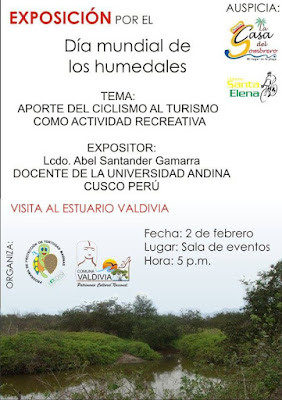“The cultural and biological diversity of wetlands represents a wealth that sustains us physically and psychologically. The cultural heritage of wetlands is the result of their ancient association with people, a relationship that has brought 'wealth' to human society and must continue to do so for future generations.”
With this statement from the Convention on Wetlands of International Importance, called the RAMSAR Convention, an intergovernmental treaty that serves as a framework for national action and international cooperation for the conservation and wise use of wetlands and their resources, World Wetlands Day is celebrated today and every February 2.
What are wetlands?
Wetlands are wetlands. The term encompasses diverse environments such as mangroves, estuaries, swamps, lakes, lagoons, flood plains, open coasts and even coral reefs. In our country, they can be found in all regions.
Wetlands contain bio-aquatic and plant resources; they are refuges for seabirds and can be used for ecotourism and agriculture. The importance varies according to their characteristics; in the case of mangroves, they serve to protect the coast and sustain the life of marine species; freshwater mangroves retain river sediments, protect the bio-aquatic population and represent a resource of great value for the subsistence of the inhabitants of communities settled in their surroundings who are dedicated to agricultural, fishing and hunting activities.
Wetlands of International Importance in Ecuador
- Churute Mangrove Ecological Reserve (Guayas) Ramsar Site No. 502
- Machalilla (Marine zone) (Manabí) Ramsar Site No. 503
- Limoncocha Biological Reserve (Sucumbíos) Ramsar Site No. 956
- Abras de Mantequilla (Los Ríos) Ramsar Site No. 1023
- La Segua (Manabi) Ramsar Site No. 1028
- Santay Island (Guayas)Ramsar Site N° 1041
- Santa Clara Island Wildlife Refuge (El Oro) Ramsar Site No. 1142
- Cube Lagoon (Esmeraldas) Ramsar Site No. 1143
- Southern Isabela Wetlands (Galapagos) Ramsar Site No. 1202
- Cajas National Park Ramsar Site No. 1203 (Azuay)
- Cayapas-Mataje Mangrove Ecological Reserve (Esmeraldas) Ramsar Site No. 1292
- Ñucanchi Turupamba Wetland Complex (Pichincha and Napo) Ramsar Site No. 1625
- Llanganati Complex (Tungurahua and Cotopaxi) Ramsar Site No. 1780
Others, although not listed by RAMSAR as being of international importance, are generally of international importance for the communities near them. For example, the Ecuasal Wetlands (province of Santa Elena), the Gulf of Guayaquil area in general, and other moorland areas (Quimsacocha for example).
THREATS:
Unsustainable human activity is perhaps one of the greatest threats to wetlands of any kind. For example, in Ecuador, páramos areas are currently seriously threatened by the interests of transnational mining companies that plan to carry out extraction work within these biologically important areas.
Other threats include: the intensification of agriculture, the construction of infrastructure (bridges, roads), urban development (very visible in cities such as Guayaquil), the introduction of species, and hunting.
![]()

